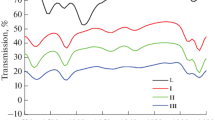Abstract
Several dinuclear diferric complexes were prepared, bridged by only an oxo ion, by an oxo ion and additionally one or two carboxylate groups, or by two hydroxo ions. Frozen solutions of these EPR-silent diferric complexes were radiolytically reduced by γ-irradiation at 77 K. The reduced forms gave EPR spectra typical of mixed-valent diiron species with S = 1/2. The yield was about 50% at high doses. With 57Fe replacing 56Fe the spectral features were broadened because of hyperfine interaction with one or both of the 57Fe nuclei. All oxo-bridged complexes give mixed-valent species with unbroadened EPR spectra observable up to 110 K. The anisotropy is small, Δg = g 1–g 3<0.07, and g av = (g 1+g 2+g 3)/3 falls in the range 1.93–1.96. Annealing at T≥115 K causes the EPR spectra to change and finally become more anisotropic, 0.14<Δg<0.32 and to have smaller g av, 1.78<g av<1.89. These spectra are observable only at T≤35 K. Radiolytic reduction of the diferric complexes with hydroxo bridges leads directly without annealing to this second type of mixed-valent species. The annealing-induced transition from a primary to a secondary mixed-valent species in the case of an oxo-bridged diferric starting complex is suggested to be a structural relaxation including protonation of the bridge. Annealing at temperatures above ca. 180 K and final thawing causes the mixed-valent dinuclear species to disappear, probably by disintegration to mononuclear species. These mixed-valent species are useful models for similar species in proteins, where primary-type species may take part in transient electron transfer, and the secondary-type species are usually more persistent forms in redox reactions. For proteins, available data show that there is a tendency for both primary and secondary species to have larger g anisotropy, Δg, and smaller g av, than obtained with the models. These differences suggest that the diiron centers of proteins are affected by their specific surroundings. Our results also show that the nature of the bridge, oxo or hydroxo, may not always safely be determined from a measured J value. Measurement of the EPR parameters, Δg, g av and limiting temperature of observation (relaxation properties) of a mixed-valent complex, or, in the case of a diferric complex, of the primary mixed-valent species induced by radiolysis at 77 K, offers an alternative empirically based method to determine the nature of the bridge.
Similar content being viewed by others
Author information
Authors and Affiliations
Additional information
Received: 8 May 1996 / Accepted: 22 January 1997
Rights and permissions
About this article
Cite this article
Davydov, R., Ménage, S., Fontecave, M. et al. Mixed-valent μ-oxo-bridged diiron complexes produced by radiolytic reduction at 77 K studied by EPR. JBIC 2, 242–255 (1997). https://doi.org/10.1007/s007750050130
Issue Date:
DOI: https://doi.org/10.1007/s007750050130




